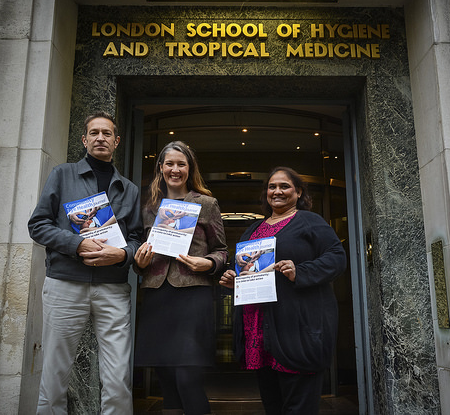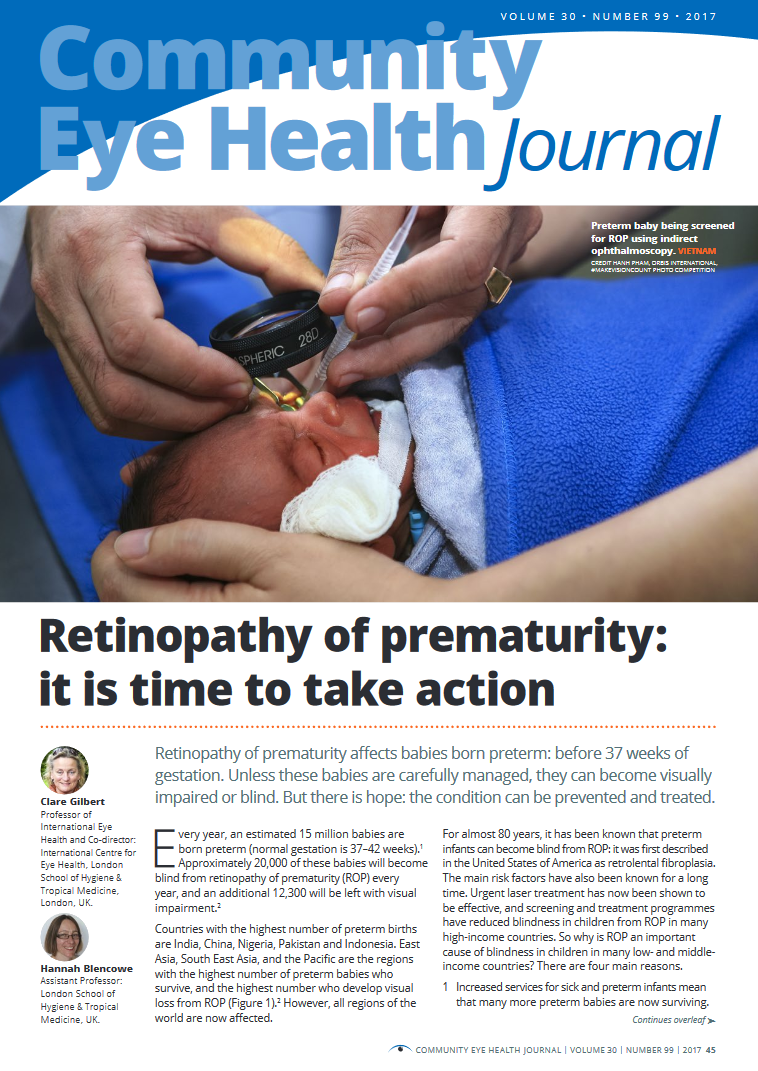Community Eye Health Journal Volume 30 | Issue 99 | 2017
Opening the eyes of eye care practitioners to prevent blindness in premature babies
Compelled to lower the incidence of global blindness, the Community Eye Health Journal has brought twelve international experts together to create a special issue on retinopathy of prematurity – a preventable cause of childhood blindness worldwide. Thanks to the generous support of the Queen Elizabeth Diamond Jubilee Trust, paper copies of the issue will be distributed to over 18,000 eye care professionals in over 184 countries.
Retinopathy of prematurity (ROP) is a significant cause of blindness among children worldwide, but is almost entirely preventable and treatable. Premature babies are often given oxygen in incubators to help them survive, but over-administration of oxygen can be highly toxic to their blood vessels, including those in the retina. Over-exposure to oxygen during the first few hours and days after birth is a major cause of ROP, as is infection.
In countries that have only recently introduced services to save the lives of preterm babies, a lack of knowledge about ROP and its treatment means that many of the babies who survive will become blind or visually impaired.
At the London School of Hygiene & Tropical Medicine, the International Centre for Eye Health produce an international eye health publication that has been delivering up-to-date, easy-to-understand and practical eye care information to front-line eye care professionals for nearly thirty years: the Community Eye Health Journal.
In this latest issue, twelve global experts in ROP have come together to bridge this gap and put up-to-date ROP knowledge and guidance in the hands of ophthalmologists, optometrists, neonatal clinicians, and nurses responsible for the care of preterm babies. Together with the Community Eye Health Journal team, and under the expert guidance of Professor Clare Gilbert, these experts have created a comprehensive guide to ROP in a single 24-page issue of the journal. It includes information about what neonatologists, nurses and parents can do in the crucial days and weeks after birth, and covers the classification, screening and treatment of ROP. Communicating and working with parents is also emphasised, as parents are an important part of the team: they can provide care during their child’s stay in the neonatal unit, and bring their child back for follow-up eye examinations after discharge, if required. An article with clear images and simple text has therefore been included to help clinicians and nurses advise parents on the importance of timely intervention to prevent blindness.
The Community Eye Health Journal is supported solely by donations from charitable organisations. At present, the budget allows for just three out of the four issues per year to be printed and distributed to the 18,000+ readers of the international edition – the fourth issue is only published online. However, thanks to the generous support of the Queen Elizabeth Diamond Jubilee Trust, over 18,000 copies of this issue has been printed and distributed. These are now on their way to front-line eye care practitioners in 184 countries worldwide. In addition, the articles will be translated into Spanish for the Community Eye Health Journal Latin American edition (which is distributed online) and will also be adapted for the South Asia edition, thereby reaching several thousand more readers in these regions.
Read the ROP issue online: www.cehjournal.org
 Caption: Professor Clare Gilbert (right) shares the ROP issue with George Smith (left) from the Queen Elizabeth Diamond Jubilee Trust
Caption: Professor Clare Gilbert (right) shares the ROP issue with George Smith (left) from the Queen Elizabeth Diamond Jubilee Trust
About retinopathy of prematurity (ROP)
Visual loss and blindness from retinopathy of prematurity (ROP) is not reversible but can be almost entirely prevented. ROP can only develop in preterm babies, as the blood vessels in their retinas are not yet fully developed at birth. ROP is more likely to develop if these babies receive too much oxygen, acquire infection, do not gain enough weight, or are otherwise unstable in the first few days and weeks of life.
About the Community Eye Health Journal
The Community Eye Health Journal is a quarterly publication for ophthalmologists, doctors and mid-level personnel (nurses, clinical officers and cataract surgeons) working in low- and middle-income countries worldwide. Every year, three out of four issues of the international edition are posted to over 18,000 readers in 184 countries, free of charge. More than 5,000 individuals receive our email newsletter, and PDF copies are available online in HTML and on PDF for free download. Visit www.cehjournal.org.
Each issue has a specific topic. Topics are adapted and/or translated to create editions for Latin America, Francophone Africa, and South Asia, which together reach an additional 8,000 readers.
The journal is published by the International Centre for Eye Health: iceh.lshtm.ac.uk based at the London School of Hygiene & Tropical Medicine: lshtm.ac.uk
About the Queen Elizabeth Diamond Jubilee Trust
The Queen Elizabeth Diamond Jubilee Trust is a charitable foundation established in 2012 to mark and celebrate Her Majesty The Queen’s sixty-year contribution to the Commonwealth. The Trust is working with the Government of India, the Public Health Foundation of India and the London School of Hygiene & Tropical Medicine to increase awareness of the condition across India and develop programmes to detect and treat ROP, and so prevent more young children from needlessly going blind. Visit www.jubileetribute.org
 Caption (left to right): Lance Bellers (Designer), Elmien Wolvaardt Ellison (Editor), and Anita Shah (Editorial Assistant)
Caption (left to right): Lance Bellers (Designer), Elmien Wolvaardt Ellison (Editor), and Anita Shah (Editorial Assistant)
Contacts:
Professor Clare Gilbert (consulting editor) Clare.Gilbert@lshtm.ac.uk +44 (0)20 7958-8332
Elmien Wolvaardt Ellison (editor) Elmien.w.Ellison@lshtm.ac.uk +44 789 734-6728

